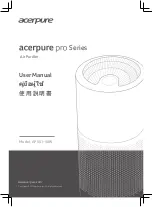
102
IM 738-2
Check, Test, and Start Procedures:
Compressor Startup
Compressor Startup
With the supply and return fans operational, prepare for
compressor operation.
The unit is shipped with refrigeration service valves closed.
Backseat (open) the discharge (suction on sizes 115 to 135),
and liquid line valves. Connect service gauges and crack the
valves off the backseat position (one turn forward). Verify that
the unit has not lost its refrigerant charge.
Verify that the crankcase heaters are operating. These should
operate for at least 24 hours before starting the compressors.
Verify that the condenser fan blades are positioned properly
and that the screws are tight (see Figure 106). The fan blade
must be correctly positioned within its orifice for proper
airflow across the condenser coils.
Figure 106. Condenser fan blade positioning
Scroll Compressor Rotational Direction
(sizes 15 to 105)
Scroll compressors only compress in one rotational direction.
Three-phase compressors rotate in either direction depending
upon phasing of the power to L1, L2, and L3. Since there is a
50/50 chance of connecting power to cause rotation in the
reverse direction, verify that the compressor rotates in the
proper direction after the system is installed. If the compressor
is rotating properly, suction pressure drops and discharge
pressure rises when the compressor is energized. If the
compressor is rotating in reverse, the sound level is louder and
current draw is reduced substantially. After several minutes of
operation, the compressor’s internal protector trips.
All three-phase compressors are wired the same internally.
Therefore, once the correct phasing is determined for a specific
system or installation, connecting properly phased power leads
to the same terminals should maintain proper rotation
direction.
Perform the following procedure on all units:
1
At the keypad, set the cooling setpoint low enough so that
the controller will call for cooling. The value in
Temperature \ Zone Cooling \ Occ Clg Spt=
will need to be
adjusted below the temperature shown in
Temperature \
Zone Cooling \ Control Temp=.
In addition, on DAC units,
the value in
Temperature \ Discharge Cooling \ DAT Clg
Spt=
will need to be adjusted below the temperature shown
in
Temperature \ Discharge Cooling \ Disch Air=
.
2
Place the unit into cooling mode through the keypad menu
System Summary \ System \ Ctrl Mode= Cool Only
.
3
Verify that the low ambient compressor lockout
temperature setpoint,
Temperature \ OA Damper \
OATComp Lock=
is set below the current outside air
temperature (shown in
System Summary \ Temperatures \
OA Temp=
).
Note:
Do not attempt to operate the compressors if the outdoor
air is too cool. See the warning statement under
“Compressor Startup” on page 102.
4
Turn the compressor control circuit switch CS1 and the
pump-down switch PS1 to ON. Now refrigeration circuit
#1 is enabled and circuit #2 is disabled. After CS1 is
closed, the MT II board starts its 5-minute timing cycle.
Note that if the unit has an economizer and the outdoor air
enthalpy is low, the economizer must fully open before the
controller will energize mechanical cooling.
5
When the outdoor air damper has fully opened and the time
delay has expired, liquid line solenoid valve SV1 should
open. If the solenoid valve does not open, do the following:
a
Verify that there is a call for cooling by checking the
keypad menu
System Summary \ System \ UnitStatus=.
This should be in
Cooling
.
b
Check the keypad menu
System Summary \ System \ Clg
Status=.
The compressors will only run if this reads
either
All Clg
or
Mech Clg
.
c
For sizes 115 to 135 units only; manually reset oil
pressure safeties if they have tripped.
d
Trace the control circuits.
6
Verify that compressor #1 starts. On units without optional
low ambient start, the compressor should start shortly after
the solenoid valve opens. On units with low ambient start,
the compressor should start when the solenoid valve opens.
If the compressor motor hums but does not run, verify that
it is getting three-phase power.
7
The compressor should operate continuously while there is
a call for cooling. If a reciprocating compressor (size 115 to
135C only) trips on oil pressure, see “Oil Pressure (sizes
CAUTION
Low ambient temperature hazard. Can cause compressor
damage.
Do not attempt to start up and check out the refrigeration
system when the outdoor air temperature is below 50°F unless
the unit is specially equipped for low ambient operation.
1.21"
NOTICE
Venting refrigerant to atmosphere is not allowed per most
local laws and/or codes
.
















































